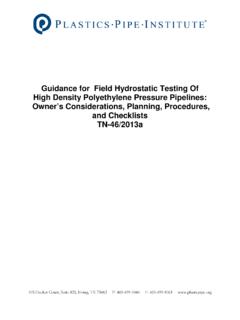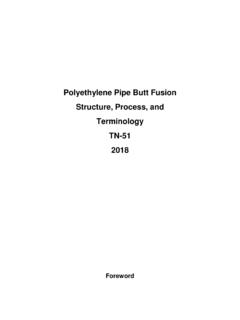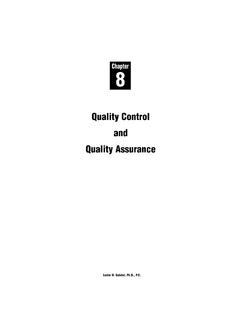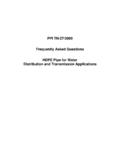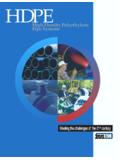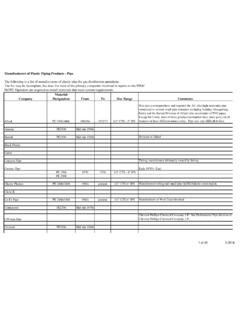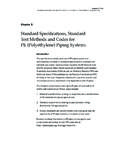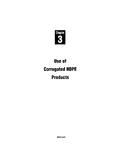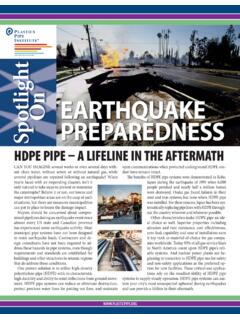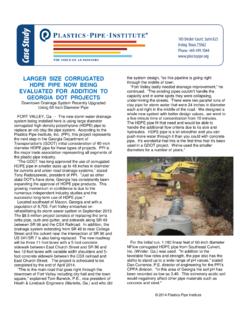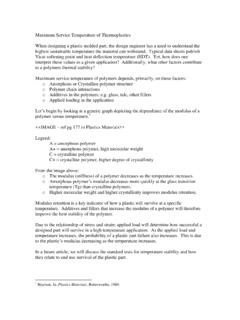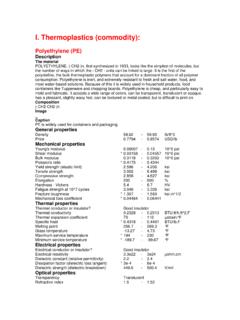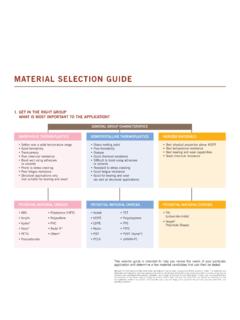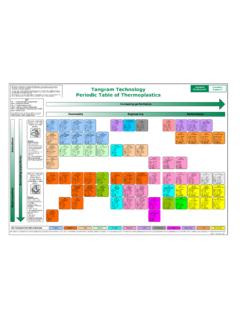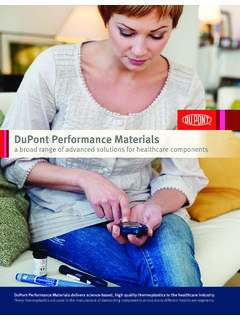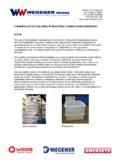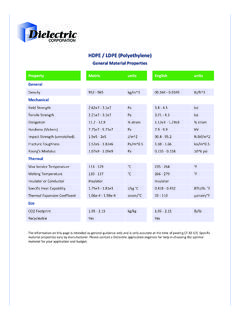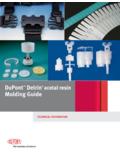Transcription of TR-19: Chemical Resistance of Thermoplastics Piping Materials
1 1 TR-19/2007 Chemical Resistance of Thermoplastics Piping Materials 105 Decker Court, Suite 825, Irving, TX 75062 P: 469-499-1044 F: 469-499-1063 1 Chemical Resistance OF Thermoplastics Piping Materials Foreword This report was developed and published with the technical help and financial support of the members of the PPI (Plastics Pipe Institute, Inc.). The members have shown their interest in quality products by assisting independent standards-making and user organizations in the development of standards, and also by developing reports on an industry-wide basis to help engineers, code officials, specifying groups, and users.
2 The purpose of this technical report is to provide information on the transport of various chemicals using thermoplastic Piping Materials . This report has been prepared by PPI as a service of the industry. The information in this report is offered in good faith and believed to be accurate at the time of its preparation, but is offered without any warranty, expressed or implied, including WARRANTIES OF MERCHANTABILITY AND FITNESS FOR A PARTICULAR PURPOSE. Consult the manufacturer for more detailed information about the particular weathering package used for its Piping products. Any reference to or testing of a particular proprietary product should not be construed as an endorsement by PPI, which do not endorse the proprietary products or processes of any manufacturer.
3 The information in this report is offered for consideration by industry members in fulfilling their own compliance responsibilities. PPI assumes no responsibility for compliance with applicable laws and regulations. PPI intends to revise this report from time to time, in response to comments and suggestions from users of the report. Please send suggestions of improvements to the address below. Information on other publications can be obtained by contacting PPI directly or visiting the web site. The Plastics Pipe Institute 469-499-1044 September 2007 2 This report has been developed as an informative guide on Resistance of thermoplastic Piping Materials to Chemical attack.
4 It is divided into two main sections: (1) a discussion of Chemical Resistance and general considerations for end use applications and (2) a listing of Chemical Resistance data (table) for several thermoplastic Piping Materials applicable to non-pressure applications. Determination of suitability for specific applications under stress (pressurized service) is beyond the scope of this report. SECTION I: Chemical Resistance IN GENERAL thermoplastic Materials generally are resistant to attack from many chemicals which makes them suitable for use in many process applications. The suitability for use in a particular process Piping application is a function of: I. material A.
5 The specific plastic material : ABS, CPVC, PP, PVC, PE, PB, PVDF, PEX1, PA11, PK B. The specific plastic material physical properties as identified by its cell classification according to the appropriate ASTM material specification. II. Product and Joint System A. Piping product dimensions, construction, and composition (layers, fillers, etc.). B. Joining system. Heat fusion and solvent cementing do not introduce different Materials into the system. Mechanical joints can introduce gaskets such as elastomers, or other thermoplastic or non- thermoplastic Materials used as mechanical fitting components. C. Other components and appurtenances in the Piping system. III.
6 Use Conditions - Internal and External A. Chemical or mixtures of chemicals, and their concentrations. B. Operating temperature maximum, minimum, and cyclical variations. C. Operating pressure or applied stress maximum, minimum and cyclical variations. D. Life-cycle information such as material cost, installation cost, desired service life, maintenance, repair and replacement costs, etc. 1 Once cross-linked, PEX is no longer considered a thermoplastic material ; however, it is included in this report as convenience for the reader. 3 Types of Chemical Attack on Plastics In general, chemicals that affect plastics do so in one of two ways.
7 One effect is Chemical solvation or permeation; the other is direct Chemical attack. Chemical Solvation or Permeation In the case of solvation or permeation, physical properties may be affected, but the polymer molecule structure itself is not chemically changed, degraded or destroyed. In solvation or permeation, gas, vapor or liquid molecules pass through the polymer, typically without damaging the plastic material itself. If the solvating Chemical can be removed completely, the plastic is generally restored to its original condition. However, removal of the Chemical is not always possible, and, in such cases, these Chemical solvation effects may be permanent. Sometimes the polymer itself may not be soluble, but it may contain a soluble compounding ingredient that may be extracted from the polymer compound.
8 This is rare because such extractable ingredients are either not used in pipe compounds, or they are chemically bonded to the molecular polymer matrix and in such small amounts that they cannot be leached out to any significant extent. Permeation may do little if any harm to the material , but it may have application-related effects. The permeating Chemical may transfer into a fluid on the other side of the pipe. In general, thermoplastic pipes should not be used where a permeating Chemical in the environment surrounding the pipe could compromise the purity of a fluid, such as potable water inside the pipe (See also PPI Statement N on Pipe Permeation). In gas or vapor transmission service, there may be a very slight loss of contents through the pipe wall.
9 Lastly, a permeating Chemical entrained in the material may be released when heat fusion or solvent cement joining is performed. Thus, heat fusion or solvent cement joining may be unreliable if performed on permeated pipes. Direct Chemical Attack Direct Chemical attack occurs when exposure to a Chemical causes a Chemical alteration of the polymer molecules by chain scission, crosslinking, oxidation or substitution reactions. Direct Chemical attack may cause profound, irreversible changes that cannot be restored by removal of the Chemical . Examples of this type of attack are 50% chromic acid at 140 F on PVC, aqua regia on PVC at 73 F, 95% sulfuric acid at 73 F on PE and wet chlorine gas on PVC and PE.
10 Direct Chemical attack frequently causes a severe reduction of mechanical physical properties such as tensile strength, ductility, and impact Resistance , and susceptibility to cracking from applied stress (stress cracking). 4 Chemical Resistance may vary greatly from one plastic material to another ( , PVC, ABS, PE, etc.), and also among different cell classifications of the same plastic type ( PVC 1120 to PVC 2110, PE 3608 to PE 4710, etc.). There may also be slight variations among commercial products having the same cell classification. The Chemical Resistance of plastic Piping is basically a function of the Chemical Resistance of the thermoplastic material , in addition to additives and other ingredients in the final compound.
